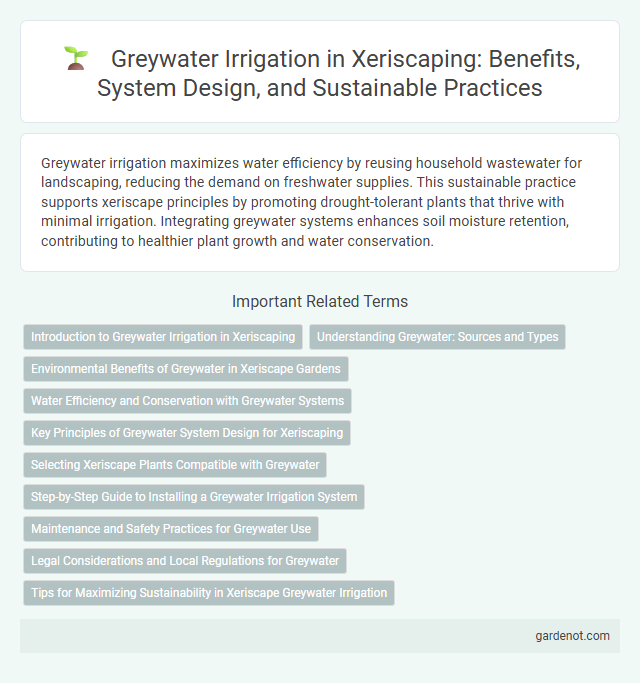Greywater irrigation maximizes water efficiency by reusing household wastewater for landscaping, reducing the demand on freshwater supplies. This sustainable practice supports xeriscape principles by promoting drought-tolerant plants that thrive with minimal irrigation. Integrating greywater systems enhances soil moisture retention, contributing to healthier plant growth and water conservation.
Introduction to Greywater Irrigation in Xeriscaping
Greywater irrigation reuses household wastewater from sinks, showers, and washing machines, excluding sewage, to sustainably water xeriscaped landscapes. This method reduces potable water demand by up to 50% while promoting healthy, drought-resistant plant growth through efficient nutrient recycling. Proper system design and treatment ensure safe application, minimizing environmental impact and maintaining soil and plant health in arid regions.
Understanding Greywater: Sources and Types
Greywater irrigation utilizes household wastewater from sinks, showers, and laundry, excluding sewage and toilet waste, to conserve freshwater in xeriscaping. Understanding greywater sources involves identifying safe, non-toxic water streams that contain minimal contaminants suitable for plant irrigation. Awareness of different greywater types--such as light greywater from hand washing and moderate greywater from laundry--ensures proper system design and effective water reuse for sustainable landscaping.
Environmental Benefits of Greywater in Xeriscape Gardens
Greywater irrigation in xeriscape gardens significantly reduces freshwater consumption by recycling household wastewater, conserving precious water resources in arid and drought-prone regions. This sustainable practice minimizes the volume of wastewater discharged into septic systems and municipal treatment plants, lowering environmental pollution and energy usage. By enhancing soil moisture retention and promoting healthy plant growth, greywater irrigation supports resilient xeriscape ecosystems while decreasing reliance on chemical fertilizers.
Water Efficiency and Conservation with Greywater Systems
Greywater irrigation enhances water efficiency by recycling household wastewater from sinks, showers, and laundry for landscape use, significantly reducing freshwater consumption. Implementing greywater systems in xeriscape landscapes conserves water resources while maintaining plant health and soil moisture. This sustainable practice minimizes strain on municipal water supplies and promotes eco-friendly water management in arid and drought-prone regions.
Key Principles of Greywater System Design for Xeriscaping
Effective greywater irrigation for xeriscaping hinges on key principles such as safe water reuse, which involves selecting biodegradable soaps and detergents to prevent soil and plant contamination. System design must prioritize low-pressure distribution to ensure even moisture delivery while minimizing runoff and erosion in drought-tolerant landscapes. Integrating subsurface drip irrigation enhances water efficiency by directly targeting plant roots, reducing evaporation and promoting healthy xeriscape growth.
Selecting Xeriscape Plants Compatible with Greywater
Selecting xeriscape plants compatible with greywater irrigation involves choosing drought-tolerant species that thrive on nutrient-rich, mildly saline water. Native plants such as lavender, rosemary, and ornamental grasses are well-suited for greywater use because they possess high tolerance to water quality variability and require minimal supplemental fertilization. Ensuring compatibility reduces plant stress, optimizes water efficiency, and supports sustainable landscaping practices.
Step-by-Step Guide to Installing a Greywater Irrigation System
Install a greywater irrigation system by first identifying appropriate water sources such as laundry or bathroom sink greywater, ensuring compliance with local regulations. Next, route greywater through a filtration system to remove debris, then direct it via a branched drain to mulch basins around drought-tolerant plants in the xeriscape landscape. Regular maintenance includes checking for clogs and system leaks to optimize water efficiency and support sustainable landscape irrigation.
Maintenance and Safety Practices for Greywater Use
Regular maintenance of greywater irrigation systems includes inspecting filters and pipes monthly to prevent clogs and bacterial buildup, ensuring system efficiency and safety. Users must avoid introducing harmful chemicals or detergents into greywater to protect plant health and soil quality, emphasizing the need for biodegradable, eco-friendly products. Implementing proper greywater diversion and storage practices minimizes risks of human contact with untreated water, adhering to local regulations for safe and sustainable irrigation.
Legal Considerations and Local Regulations for Greywater
Legal considerations for greywater irrigation vary significantly across regions, with many local regulations requiring permits to ensure safe use and prevent environmental contamination. Specific guidelines often dictate the type of greywater that can be reused, acceptable irrigation methods, and setbacks from potable water sources to protect public health. Compliance with state and municipal codes is essential to implement greywater systems legally and effectively in xeriscape landscaping.
Tips for Maximizing Sustainability in Xeriscape Greywater Irrigation
Optimize xeriscape greywater irrigation by selecting drought-tolerant plants and ensuring greywater is filtered to remove contaminants, protecting soil and plant health. Implement drip irrigation systems to minimize water waste and improve efficiency in delivering greywater directly to the root zone. Regularly monitor soil moisture and maintenance needs to prevent over-irrigation and enhance long-term sustainability in xeriscape landscapes.
Greywater irrigation Infographic

 gardenot.com
gardenot.com